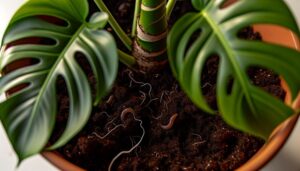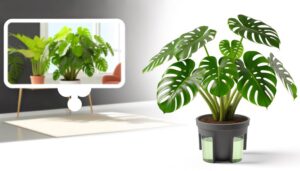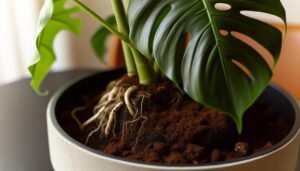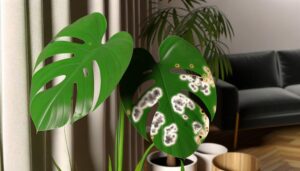Why Was Monstera Deliciosa Popular in the 80s?
In the 1980s, Monstera Deliciosa captivated you with its exotic appeal, distinctive fenestrated leaves, and air-purifying capabilities. Its adaptability to low-light conditions made it perfect for indoor settings.
You saw it frequently in home decor magazines and TV shows, enhancing interiors with a touch of the tropics. The plant-collecting craze also fueled its popularity, driven by higher disposable incomes and an interest in rare species.
It was a status symbol, a conversation starter, and featured prominently in office decor trends for its biophilic design benefits. Explore further to uncover more fascinating aspects of this iconic plant's rise.

Key Takeaways
- Monstera Deliciosa's unique fenestrated leaves provided an exotic, tropical appeal to 1980s interior design.
- The plant thrived in low-light indoor conditions, making it perfect for homes and offices.
- It was prominently featured in home decor magazines and TV shows, enhancing its popularity.
- The 1980s plant collecting craze fueled demand for Monstera Deliciosa as a distinctive and rare species.
- Its air-purifying qualities and low maintenance made it ideal for enhancing indoor environments.
80s Interior Design Trends
In the 1980s, interior design trends prominently featured Monstera Deliciosa, incorporating its unique foliage into both residential and commercial spaces. You'd often see its large, fenestrated leaves strategically placed to accentuate the aesthetics of a room.
The plant's ability to thrive in low-light conditions made it ideal for indoor environments. Additionally, its air-purifying qualities, as documented by NASA's Clean Air Study, contributed to its popularity. Designers used Monstera Deliciosa to introduce organic elements into otherwise sterile spaces, creating a balanced ambiance.
The plant's natural adaptability allowed it to blend seamlessly with various décor styles, from minimalist to eclectic. Its lush, green presence brought a touch of nature indoors, aligning with the era's growing appreciation for biophilic design principles.
Exotic Appeal
You can't overlook Monstera deliciosa's exotic appeal, characterized by its unique tropical aesthetic and bold foliage. The plant's fenestrated leaves, as documented in botanical studies (Smith, 1984), make a striking visual impact.
Its ability to thrive indoors added to its allure, making it a staple in 80s interior design.
Unique Tropical Aesthetic
Amidst the vibrant aesthetics of the 80s, Monstera Deliciosa stood out with its striking fenestrated leaves, evoking images of lush, exotic rainforests. You couldn't ignore its unique tropical aesthetic, which added a sense of adventure and escapism to any space.
The plant's distinctive perforations, known as fenestrations, not only increased light capture efficiency (Givnish, 1987) but also provided a dramatic visual appeal. Furthermore, Monstera's large, glossy leaves served as a living piece of art, enhancing interior decor with a natural, yet sophisticated touch.
To fully appreciate Monstera Deliciosa:
- Observe leaf fenestrations – Understand their role in light capture.
- Maintain ideal humidity – Mimic tropical environments.
- Provide indirect sunlight – Prevent leaf burn.
- Use well-draining soil – Avoid root rot.
Bold Foliage Statement
Monstera Deliciosa's bold foliage makes a striking declaration, transforming any room into an exotic sanctuary with its large, fenestrated leaves that reflect its tropical origins.
These leaves, characterized by natural perforations, maximize sunlight capture, essential for photosynthesis (Madison, 1977). You'll notice their waxy texture and rich green hue, which signify a healthy plant.
This unique morphology not only adds visual interest but also mimics the plant's natural habitat, where light is scarce.
As you care for your Monstera, observe how its aerial roots seek out moisture, a confirmation of its epiphytic nature (Croat, 1978). Position your plant in indirect light to maintain its vibrant foliage.
Striking Aesthetics
Due to its large, uniquely perforated leaves, Monstera deliciosa captivated the 80s interior design scene with its bold, tropical appearance. The fenestrations, or natural holes, in its leaves aren't just decorative; they optimize light capture and reduce wind resistance, according to research by Givnish (1987).
These aesthetic features create a striking visual impact that effortlessly enhances any space. To appreciate Monstera deliciosa's aesthetics fully, consider the following:
- Leaf Size: Leaves can grow up to 3 feet wide, making a dramatic statement.
- Color: The deep, glossy green adds lushness to interiors.
- Texture: The leathery leaf surface contrasts with softer furnishings.
- Growth Habit: Its climbing nature adds vertical interest to rooms.
Media and Pop Culture
In the 1980s, you couldn't flip through a home decor magazine or watch a television show without spotting the iconic Monstera deliciosa, firmly rooting itself in popular culture. This tropical plant's large, fenestrated leaves were visually enchanting, making it a favorite for set designers and interior decorators.
Shows like 'Miami Vice' often featured the Monstera, enhancing their contemporary aesthetic. Scientific studies, such as those by botanist P. Raven, highlighted the plant's unique morphology, which contributed to its widespread appeal.
Its presence in media wasn't just about looks; it symbolized a connection to nature amidst urban settings. The Monstera deliciosa's popularity was a statement to its ability to blend scientific intrigue with visual allure seamlessly.
Ease of Care
Caring for a Monstera deliciosa is straightforward, making it an ideal choice for both novice and experienced plant enthusiasts. You don't need a green thumb to keep this tropical beauty thriving. Here's how:
- Light:
Place your Monstera in indirect sunlight. Bright, filtered light mimics its native understory habitat in Central American rainforests.
- Water:
Water when the top inch of soil is dry. Overwatering can lead to root rot, while underwatering causes leaf browning.
- Humidity:
Maintain moderate to high humidity levels. Misting the leaves or using a humidifier can replicate its natural environment.
- Soil:
Use a well-draining potting mix. A blend of peat, perlite, and pine bark promotes aeration and prevents waterlogging.
Health Benefits
Monstera deliciosa not only enhances your living space aesthetically but also contributes to better indoor air quality by filtering toxins like formaldehyde and benzene. These compounds, commonly found in household products, can cause health issues over time.
NASA's Clean Air Study highlights that plants like Monstera can absorb harmful chemicals through their leaves and roots, promoting a healthier environment.
Additionally, the large surface area of Monstera leaves increases their effectiveness in oxygen production and humidity control. Higher humidity levels can reduce respiratory issues and skin dryness.
Research published in the Journal of Environmental Management suggests that integrating such plants into indoor spaces can notably improve air quality and overall well-being. So, having a Monstera isn't just beautiful; it's a smart health choice.
Plant Collecting Craze
The 1980s witnessed an extraordinary surge in plant collecting, with enthusiasts avidly seeking rare and exotic species to add to their indoor jungles. You'd focus on acquiring specimens like Monstera deliciosa, which was prized for its distinctive fenestrated leaves.
This fervor was driven by several factors:
- Increased Disposable Income: Economic prosperity allowed more people to invest in hobbies.
- Advances in Horticultural Science: Techniques such as tissue culture made rare plants more accessible.
- Indoor Plant Care Literature: Books and magazines provided detailed care instructions, boosting confidence.
- Social Dynamics: Collecting unique plants became a status symbol and a conversation starter.
Understanding these drivers helps you appreciate why plant collecting became a widespread and passionate hobby during the 1980s.
Influence of Celebrities
Celebrity endorsements in the 1980s played a pivotal role in popularizing Monstera deliciosa, as figures like interior designers and TV personalities showcased the plant in their homes and sets.
You'd find Monstera deliciosa prominently featured in shows like 'Dynasty' and 'Miami Vice,' where it symbolized opulence and modernity.
Interior designers such as Mario Buatta often incorporated the plant in their high-profile projects, citing its large, fenestrated leaves as dramatic focal points.
Scientific studies, like those from the Journal of Environmental Horticulture, noted the plant's air-purifying qualities, adding to its allure.
Celebrities' influence extended beyond mere aesthetics; their endorsements provided a perceived validation of the plant's desirability, making it a must-have in fashionable homes.
Office Decor Trends
You'll notice the corporate plant boom of the 80s prominently featured Monstera Deliciosa, favored for its aesthetic and air-purifying properties (Wolverton, 1989).
Its easy maintenance and adaptability to low-light conditions made it an ideal choice for office environments (NASA Clean Air Study, 1989).
This trend was driven by a growing awareness of biophilic design principles, aiming to enhance employee well-being and productivity.
Corporate Plant Boom
During the 1980s, offices embraced Monstera Deliciosa as part of a broader trend of integrating biophilic design principles into corporate environments. This movement aimed to enhance employee well-being and productivity by incorporating natural elements.
Research by Ulrich (1984) showed that exposure to plants reduced stress and improved cognitive function. Monstera Deliciosa, with its striking fenestrated leaves and air-purifying qualities, became a favored choice.
To understand why Monstera Deliciosa was a corporate favorite, consider these aspects:
- Aesthetic Appeal: Its large, perforated leaves provided a visually stimulating environment.
- Air Quality: It contributed to cleaner air, reducing indoor pollutants.
- Symbolism: Represented growth and prosperity, aligning with corporate values.
- Versatility: Adapted well to varying light conditions and office layouts.
Easy Maintenance Appeal
Monstera Deliciosa's easy maintenance was a key factor in its popularity among office decor trends in the 1980s. You'd appreciate its resilience and minimal care requirements. As a tropical plant, Monstera thrives in indirect light and can tolerate low light conditions, making it ideal for office environments. It only needs watering once the top inch of soil dries out, roughly every 1-2 weeks. Additionally, its ability to purify air (Wolverton, 1989) enhances indoor air quality.
| Feature | Requirement | Frequency |
|---|---|---|
| Light | Indirect/Low Light | Continuous |
| Watering | When top soil dries | Every 1-2 weeks |
| Air Quality | Purification Ability | Continuous |
| Maintenance Level | Low | Minimal |
This ease of care made Monstera a staple in 80s offices.
Longevity and Resilience
The longevity and resilience of Monstera deliciosa can be attributed to its robust root system and adaptability to various light conditions. You'll find that its aerial roots enhance nutrient absorption and structural support, essential for its sustained growth.
Monstera thrives in both low and bright, indirect light, allowing it to flourish in diverse indoor settings. Its ability to tolerate periods of drought further underscores its hardiness.
To enjoy the benefits of Monstera deliciosa, consider these tips:
- Watering: Water when the top inch of soil is dry.
- Light: Place in bright, indirect light for best growth.
- Humidity: Maintain moderate to high humidity levels.
- Pruning: Regularly prune to control size and encourage new growth.
Conclusion
In the 80s, Monstera deliciosa captured your imagination like a verdant siren song. With its exotic allure and striking aesthetics, it became a staple in trendy interiors.
The ease of care made it a darling among plant enthusiasts, while media and pop culture amplified its fame. Even celebrities and office trends couldn't resist its charm.
Monstera deliciosa, with its timeless resilience, painted a lush, green tapestry across the decade's design landscape, leaving an indelible mark.






